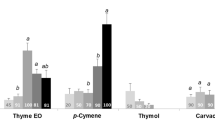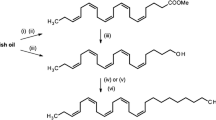Abstract
As the ratio of (E)-8-dodecenyl acetate (E8–12∶Ac) to (Z)-8-dodecenyl acetate (Z8–12∶Ac) increased past optimal low levels in the pheromone blend, fewer males were able to fly 2.5 m upwind to the source. The tracks of males that flew in plumes of such high-(E)off-blends were slower and narrower than those of males flying to lower-(E)blends. The tracks were narrower, first of all, because as the proportion of E8–12∶Ac increased, the males steered more into the wind. More of their thrust was directed upwind and therefore their groundspeed to either side of the windline was reduced. In addition, males also reduced their airspeeds to high-(E)blends, which contributed to the decreased groundspeeds and narrower tracks. No significant changes in the frequency of counterturning were found in response to increasing proportions of E8–12∶Ac. The inability to continue upwind flight in a plume of an off ratio was indicated by in-flight arrestment in the plume. Arrestment resulted from changes in the course angles steered by the males and the airspeeds flown.
Similar content being viewed by others
References
Baker, P. S., Gewecke, M., and Cooter, R. J. (1981). The natural flight of the migratory locustLocusta migratoria L.J. Comp. Physiol. 141: 233–237.
Baker, T. C. (1985). Chemical control of behavior. In Kerkut, G. A., and Gilbert, L. I. (eds.), Comprehensive Insect Physiology, Biochemistry and Pharmacology, Pergamon Press, Oxford.
Baker, T. C. (1988). Pheromones and flight behavior. In Goldsworthy, G., and Wheeler, C. (eds.), inInsect Flight, CRC Press, Boca Raton, Fla. (in press).
Baker, T. C., and Cardé, R. T. (1979). Analysis of pheromone-mediated behaviors in maleGrapholita molesta, the oriental fruit moth (Lepidoptera: Tortricidae).Environ. Entomol. 8: 956–968.
Baker, T. C., and Haynes, K. F. (1987). Manoevers used by flying male oriental fruit moths to relocate a sex pheromone plume in an experimentally shifted wind-field.Physiol. Entomol. 12: 263–279.
Baker, T. C., Meyer, W., and Roelofs, W. L. (1981). Sex pheromone dosage and blend specificity of response by oriental fruit moth males.Entomol. Exp. Appl. 30: 269–279.
Cardé, A. M., Baker, T. C., and Cardé, R. T. (1979). Identification of a four-component sex pheromone of the female oriental fruit moth,Grapholitha molesta (Lepidoptera: Tortricidae).J. Chem. Ecol. 5: 423–427.
David, C. T. (1982). Compensation for height in the control of groundspeed byDrosophila in a new, “barber's pole” wind tunnel.J. Comp. Physiol. 147: 485–493.
David, C. T. (1986). Mechanisms of directional flight in wind. In Payne, T., Birch, M., and Kennedy, C. (eds.),Mechanisms In Insect Olfaction, NSF-NATO Symposium on Insect Olfaction, Oxford, Clarendon Press, Oxford.
Farkas, S. R., Shorey, H. H., and Gaston, L. K. (1974). Sex pheromones of lepidoptera. Influence of pheromone concentration and visual cues on aerial odor-trail following by males ofPectinophora gossypiella.Ann. Entomol. Soc. Am. 67: 633–638.
Fraenkel, G. S., and Gunn, D. L. (1961).The Orientation of Animals Kineses Taxes and Compass Reactions, Dover, New York, pp. 11–23.
Kennedy, J. S. (1940). The visual responses of flying mosquitoes.Proc. Zool. Soc. Lond. A 109: 221–242.
Kennedy, J. S. (1983). Zigzagging and casting as a programed response to wind-bome odour: A review.Physiol. Entomol. 8: 109–120.
Kuenen, L. P. S., and Baker, T. C. (1982). The effects of pheromone concentration on the flight behavior of the oriental fruit moth,Grapholitha molesta.Physiol. Entomol. 7: 423–434.
Linn, C. E., and Roelofs, W. L. (1981). Modification of sex pheromone blend discrimination in male oriental fruit moths by pre-exposure to (E)-8-dodecenyl acetate.Physiol. Entomol. 6: 421–429.
Linn, C. E., and Roelofs, W. L. (1983). Effect of varying proportions of the alcohol component on sex pheromone blend discrimination in male oriental fruit moths.Physiol. Entomol. 8: 291–306.
Ludlow, A. R. (1984).Applications of Computer Modelling to Behavioural Co-ordination, Ph.D. thesis, University of London, London.
Marsh, D., Kennedy, J. S., and Ludlow, A. R. (1978). An analysis of anemotactic zigzagging flight in male moths stimulated by pheromone.Physiol. Entomol. 3: 221–240.
Miller, J. R., and Roelofs, W. L. (1978). Sustained-flight tunnel for measuring insect responses to wind-borne sex pheromones.J. Chem. Ecol. 4: 187–198.
Roelofs, W. L. (1980). Pheromones and their chemistry. In Locke, M., and Smith, D. S. (eds.),Insect Biology in the Future, Academic Press, New York, pp. 583–602.
Roelofs, W. L., and Cardé, R. T. (1977). Responses of lepidoptera to synthetic sex pheromone chemicals and their analogues.Annu. Rev. Entomol. 22: 377–405.
Roelofs, W. L., Comeau, A., and Selle, R. (1969). Sex pheromone of the oriental fruit moth.Nature 224:723.
Ryan, T. A. (1960). Significance tests for multiple comparison of proportions, variances and other statistics.Psychol. Bull. 57: 318–328.
Vogel, S. (1967). Flight inDrosophila, II. Variations in stroke parameters and wing contour.J. Exp. Biol. 46: 383–392.
Willis, M. A., and Baker, T. C. (1987). Comparison of manoeuvers used by walking versus flying males during pheromone-mediated upwind movement.J. Insect. Physiol. 33: 875–883.
Author information
Authors and Affiliations
Rights and permissions
About this article
Cite this article
Willis, M.A., Baker, T.C. Effects of varying sex pheromone component ratios on the zigzagging flight movements of the oriental fruit moth,Grapholita molesta . J Insect Behav 1, 357–371 (1988). https://doi.org/10.1007/BF01054498
Accepted:
Issue Date:
DOI: https://doi.org/10.1007/BF01054498




